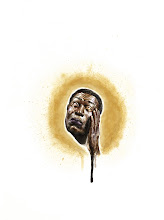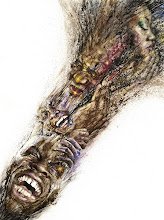The following paintings are interpretive of actual unsolved civil rights era murder cases in which no one was ever brought to justice. The paintings are visual aids to the pain and suffering of the victims from these actual murder cases. The paintings were created to raise awareness and to pursue justice for these cold cases all these years later. This is a very important part of American history that is not talked about enough. In order to move forward combatting racism we must bring justice for those whom our justice system failed. Please read each case file before looking at the painting.
The Johnnie Mae Chappell Case
On the evening of March 23, 1964, MRS. JOHNNIE MAE CHAPPELL, mother of ten, had just been grocery shopping for her family at a local store. Upon arriving home, she discovered that her wallet was missing. Accompanied by two neighbors, Mrs. Chappell retraced her steps to a local highway to look for her wallet.
As the riots flared in downtown Jacksonville, four young white men were drinking beer and discussing the racial “troubles” when they allegedly decided “to find themselves a nigger to shoot.” As they drove down the highway, they noticed a small group of black people walking along the side of the road. The car slowed down and one of the men cold-bloodedly fired his rifle from the window. Johnnie Mae Chappell was struck and killed by a single gunshot from the passing car.
After a flawed investigation by local officials, J.W. Rich (the shooter), Elmer Kato, Wayne Chessman and James Davis were indicted on First Degree Murder charges for the death of Mrs. Chappell. Only J.W. Rich went to trial where he was subsequently convicted on the lesser charge of Manslaughter. The other men walked free, even though one of them had confessed his involvement in the crime to a local detective.
On April 27, 2004, forty years after the crime, Governor Jeb Bush asked the Florida Department of Law Enforcement to reopen the Johnnie Mae Chappell case in hopes of having first degree murder charges reinstated on the three un-indicted murder suspects. These men are now in their late 60’s and still live in Jacksonville.
Moore’s Ford Case

On July 25, 1946, four young African Americans -- George & Mae Murray Dorsey and Roger & Dorothy Malcom were shot hundreds of times by 12 to 15 unmasked white men in broad daylight at the Moore's Ford Bridge spanning the Apalachee River, 60 miles east of Atlanta, Georgia. These killings, for which no one was ever prosecuted, enraged President Harry Truman and led to historic changes but were quickly forgotten in Oconee and Walton Counties where they occurred. No one was ever brought to justice for the crime.
Rev. George W. Lee Case

On May 7, 1955, The Rev. George Lee, a minister who also ran a local grocery and printing press in Belzoni, was preaching about voting rights in black Baptist churches more than a decade before the height of the civil rights movement. Lee and a friend started a local chapter of the NAACP and convinced nearly 100 black people to register to vote before resistance began turning violent. Lee was driving home one day when he was hit with gunfire from a passing car. Without investigating, the Humphreys County sheriff claimed that Lee's death was a traffic accident. Asked about the lead pellets taken from Lee's face and head, the sheriff replied they were probably dental fillings. The coroner ruled the death resulted from "unknown causes." No one was ever arrested in the case
Willie Edward’s Case
 Recently hired to drive trucks for Winn-Dixie, Willie Edwards left the afternoon of January 23, 1957, never to return home. Three months passed before his body washed up on the shores of the Alabama River. Officials stated that decomposition made it impossible to determine the cause of death.
Recently hired to drive trucks for Winn-Dixie, Willie Edwards left the afternoon of January 23, 1957, never to return home. Three months passed before his body washed up on the shores of the Alabama River. Officials stated that decomposition made it impossible to determine the cause of death. In 1976, then State Attorney General Bill Baxley re-opened the Edwards case. Four people were arrested and charged with Edward's murder: Sonny Kyle Livingston Jr., 38, Henry Alexander, 46, James York, 73 and Raymond Britt (Jr). Britt broke the long silence with his sworn affidavit (in exchange for immunity), dated February 20, 1976. In the statement to Attorney General Bill Baxley, Britt describes how on the night of January 23, 1957, he along with three other men beat and forced Edwards to jump off the Tyler-Goodwin Bridge into the Alabama River.
Alabama Judge Frank Embry dismissed the charges, even with Britt's sworn testimony because no cause of death was ever established. He concluded that "merely forcing a person to jump from a bridge does not naturally and probably lead to the death of such person." Edwards fell 125 feet (27 metres), from the bridge into the Alabama River below.
Case Re-opened: Twenty-one years passed before Malinda Edwards made her plea to Montgomery District Atorney Ellen Brooks for justice in her father's case. Brooks responded by reopening the investigation. In late 1997, State Medical Examiner, Dr. James Lauridson acting on a request from Brooks, exhumed and re-examined Edwards's remains. Based on the re-examination of Edwards' remains using modern technology, Dr. Lauridson ruled the cause of Edwards' death to be homicide.
Brooks filed a motion with the court to have Edwards's death certificate reflect Dr. Lauridson's findings. Judge Charles Price ordered the Alabama Department of Vital Statistics to change Edwards' cause of death from unknown to drowning by homicide.
Dr. Lauridson's ruling and Judge Price's order resolved the legal problem that caused Judge Embry to dismiss the case in 1976. Brooks took the case before the County Grand Jury.
The Grand Jury concluded that Edwards was murdered by the Ku Klux Klan, but didn't feel there was sufficient evidence for new indictments. Brooks, speaking to a column in the Montgomery Advertiser dated March 2, 1999 said that because most of the key witnesses were dead, it was difficult to prosecute the case. Britt recanted his assertions regarding the involvement of Alexander; both Livingston and York were dead at this time (Livingston's wife came forward in 1993 saying her husband confessed to the murder on his deathbed). The Grand Jury refused to return an indictment. Malinda Edwards, who was 5 years old when her father was murdered, remains hopeful that a successful prosecution can be brought to fruition.
Rev. Lamar Smith Case
Aug. 13, 1955, Lamar Smith was a World War II veteran, a farmer and a local leader in the black community in Brookhaven, Mississippi. He organized voter registration drives and even campaigned against an incumbent county supervisor. One August day shortly after an election he was downtown on business when he and some white men got in an argument. A number of witnesses saw one of the white men pull out a .38-caliber pistol and shoot Smith at close range. Three men were arrested but went free when none of the witnesses would testify to what they had seen.
 Recently hired to drive trucks for Winn-Dixie, Willie Edwards left the afternoon of January 23, 1957, never to return home. Three months passed before his body washed up on the shores of the Alabama River. Officials stated that decomposition made it impossible to determine the cause of death.
Recently hired to drive trucks for Winn-Dixie, Willie Edwards left the afternoon of January 23, 1957, never to return home. Three months passed before his body washed up on the shores of the Alabama River. Officials stated that decomposition made it impossible to determine the cause of death.



















1 comment:
I know this is from forever ago but, Sonny Livingston is still alive and runs a bail bonds company in Montgomery, AL. The man that confessed to the murder on his death bed was Henry Alexander. Just figured you should know to check your facts before you try to write a story.
Post a Comment